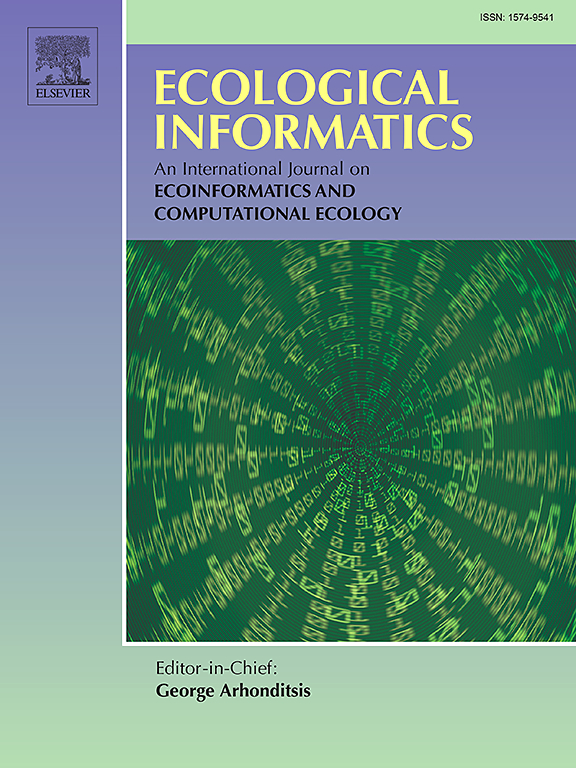Phytoplankton group classification by integrating trait information and observed environmental thresholds
IF 7.3
2区 环境科学与生态学
Q1 ECOLOGY
引用次数: 0
Abstract
Assigning phytoplankton taxa into functional groups is a common requirement for process-based models of aquatic ecology, yet it can be challenging in systems with large taxonomic diversity and remains a largely subjective task. In the absence of a clear and transferrable framework, modellers often default to the delineation of phytoplankton groups at the phyla or class level (e.g., diatoms, greens, etc.). However, this approach aggregates the substantial functional and trait diversity that occurs within these groups, creating challenges for model parameterization and assessment. To address this issue, we developed a data-driven approach to define phytoplankton functional groups considering species trait information and occurrence data. The framework calculates the observed environmental thresholds for species monitored in a 12-year dataset from the Hawkesbury-Nepean River (Sydney, Australia), combined with a priori species-level trait information (e.g., organism structure, biovolume, movement types, and nutrient acquisition strategies). We minimized subjectivity in phytoplankton group classification by first applying multiple correlation analysis and principal component analysis to identify the most important environmental factors for threshold analysis. Second, we used Threshold Indicator Taxa Analysis (TITAN) to detect the ecological threshold ranges summarizing species occurrence along environmental gradients of total phosphorus, total nitrogen, the ratio of total nitrogen to total phosphorus, and temperature. Third, we applied K-prototype clustering for group classification based on the identified thresholds and associated traits. Our approach identified five discrete phytoplankton groups with statistically distinct features of environmental preference and morphological and physiological characteristics. The advantage of the method is that the identified groups better reflect the ecological characteristics of the phytoplankton community considering the local environmental requirements, which better aligns with the process parameterizations used in numerical phytoplankton models. This framework can be applied in other aquatic systems as a robust and repeatable way to integrate long-term phytoplankton taxonomic and environmental datasets for water quality analyses.
结合性状信息和观测环境阈值的浮游植物类群分类
将浮游植物分类群划分为功能群是水生生态过程模型的一个共同要求,但在分类多样性大的系统中,这可能是一个挑战,并且仍然是一个很大程度上主观的任务。在缺乏清晰和可转移的框架的情况下,建模者通常默认在门或纲水平上描述浮游植物群(例如,硅藻、绿色植物等)。然而,这种方法聚集了这些群体中发生的实质性功能和性状多样性,为模型参数化和评估带来了挑战。为了解决这个问题,我们开发了一种数据驱动的方法来定义浮游植物的功能群,考虑物种特征信息和发生数据。该框架计算了在澳大利亚悉尼霍克斯伯里-尼潘河(Hawkesbury-Nepean River) 12年数据集中监测的物种所观察到的环境阈值,并结合了先验的物种水平特征信息(例如,生物结构、生物体积、运动类型和营养获取策略)。首先采用多元相关分析和主成分分析方法,找出最重要的环境因子进行阈值分析,最大限度地减少了浮游植物类群分类中的主观性。其次,采用阈值指标分类群分析(TITAN)方法,沿全磷、全氮、全氮/全磷、温度等环境梯度,检测物种发生的生态阈值范围。第三,基于识别的阈值和相关特征,应用k -原型聚类进行群体分类。我们的方法确定了五个离散的浮游植物群,它们在统计上具有不同的环境偏好特征和形态和生理特征。该方法的优势在于,所识别的群落能更好地反映浮游植物群落的生态特征,考虑到当地的环境要求,这与浮游植物数值模型中使用的过程参数化更吻合。该框架可应用于其他水生系统,作为整合长期浮游植物分类和环境数据集进行水质分析的可靠和可重复的方法。
本文章由计算机程序翻译,如有差异,请以英文原文为准。
求助全文
约1分钟内获得全文
求助全文
来源期刊

Ecological Informatics
环境科学-生态学
CiteScore
8.30
自引率
11.80%
发文量
346
审稿时长
46 days
期刊介绍:
The journal Ecological Informatics is devoted to the publication of high quality, peer-reviewed articles on all aspects of computational ecology, data science and biogeography. The scope of the journal takes into account the data-intensive nature of ecology, the growing capacity of information technology to access, harness and leverage complex data as well as the critical need for informing sustainable management in view of global environmental and climate change.
The nature of the journal is interdisciplinary at the crossover between ecology and informatics. It focuses on novel concepts and techniques for image- and genome-based monitoring and interpretation, sensor- and multimedia-based data acquisition, internet-based data archiving and sharing, data assimilation, modelling and prediction of ecological data.
 求助内容:
求助内容: 应助结果提醒方式:
应助结果提醒方式:


